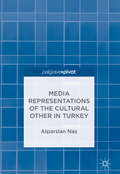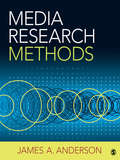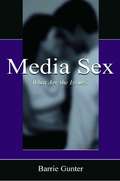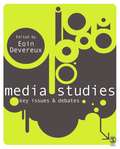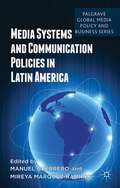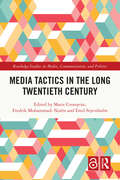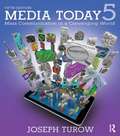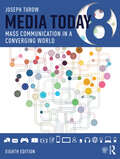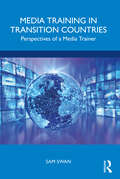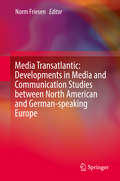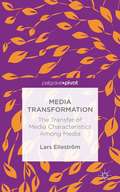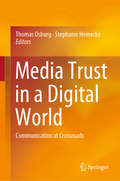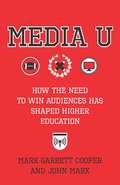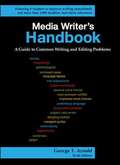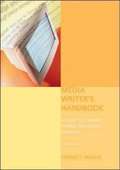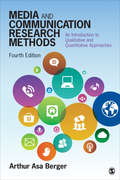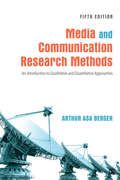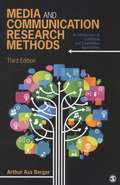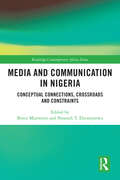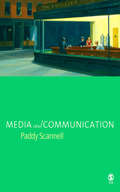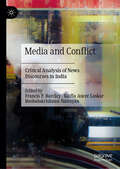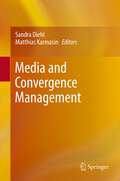- Table View
- List View
Media Representations of the Cultural Other in Turkey
by Alparslan Nas“A fresh study that confirms the existence of multiple peripheries (and its others) in Turkish society and how dominant centrist media represented these differences in film and television discourse. The use of Mardin’s center-periphery concept for the analyses of films, ads and cartoons is brilliant. This is a timely project as scholarly interest in Turkey has increased exponentially since 2013. This project is key to understanding the roots of a media politics in contemporary Turkey.”—Murat Akser, Ulster University, UK“Alparslan Nas' seminal work disrupts the notion of Turkish identities as fixed and stable. He challenges the center (secular, modern, Western)/ peripheral (conservative, religious) binary by critically examining how a cultural “other” is constructed and performed through the media in Turkey. Nas’ analysis offers a (much needed) new lens and approach to understanding Turkey’s complex social and political landscape.”—Kathleen Cavanaugh, National University of Ireland, Galway, IrelandThis book is an important contribution to the scholarship on Turkey’s cultural and political dynamics, facilitating a discussion on the recent depictions of the cultural other in the media. Turkey’s modern history has been characterized by a particular tension between the social classes occupying the “center” of society: while the bureaucratic elite are represented as modern, secular and westernized, the “peripheral” communities are portrayed as conservative, religious or non-Turkish. This book facilitates a timely intervention to problematize this possible perception and to point at the complex dynamics of center-periphery relations through the representation of the cultural other in film, television, advertisements and cartoons, which have all been produced by different social classes. Ultimately, Media Representations of the Cultural Other in Turkey argues that the notions of the center and periphery do not signify stable positions; rather, each social agent imagines themselves at the center, the cultural other at their periphery providing a crucial tool for the realization of their own identity.
Media Research Methods: Understanding Metric and Interpretive Approaches
by James A. AndersonMedia Research Methods: Understanding Metric and Interpretive Approaches brings the insights of a senior theorist, methodologist, and critic to the classroom. Departing from the methods recipe approach, the text explains the reasons behind the methods and makes the connections to theory and knowledge production. Written in a conversational style, the book engages students and appeals to them as media consumers and users of research. The book takes the reader through each step of the research process, outlining the procedures, differences, strengths and limitations of metric, interpretive and the newer hybrid approaches. The text lays down a strong foundation in empirical research and problem solving, addressing metric topics of hypotheses, sampling, statistics, survey and experimental protocols and interpretive topics of textual analysis, coding, critical engagement and ethnography. A special chapter at the end of the book is a helpful guide for those readers who aspire to a research and analysis career.
Media Sex: What Are the Issues? (Routledge Communication Series)
by Barrie GunterThis book examines the representation, impact, and issues relating to the control and regulation of sex in the media. It covers work that has been conducted around the world on the depiction of sex in the mainstream mass media, especially the audio-visual media of film, television, and video, and the alleged effects that such content may have upon media consumers. In addition to reviewing the research on the effects of media sex, the book also examines what is known about public opinion concerning sex in the media. A key theme running through the book is whether the evidence about media sex can be taken at face value. Are the methodologies used by researchers to investigate media sex problematic? Have they yielded data that can be questioned in terms of validity and reliability? Media Sex questions whether media sex poses a serious problem for most viewers of mainstream media. It acknowledges that there may be serious issues relating to the causation of public offense and the cultivation of anti-women attitudes and beliefs that need to be addressed in productions where more extreme forms of sexual conduct are combined with violent and sadistic behavior. With the unrelenting growth of media, media consumers demand and are given greater personal control over the reception of media content. The notion of freedom of speech conflicts with the view that media content needs to be centrally regulated and controlled. This conflict creates problems for regulatory organizations and the legislators in nation states in which freedom of the press is legally protected. The book examines the debate surrounding this conflict.
Media Studies: Key Issues and Debates
by Eoin DevereuxBringing together a range of renowned scholars in the field, this book examines eighteen key issues within contemporary media studies. Written in an accessible student-friendly style, Media Studies - Key Issues and Debates is an authoritative landmark text for undergraduate students. Each individual chapter begins with a concise definition of the concept(s) under investigation. This is followed by a 5,000 word discussion on the current state of play within research on the specific area. Chapters contain case-studies and illustrative materials from Europe, North America, Australasia and beyond. Each chapter concludes with annotated notes, which guide the student-reader in terms of future study. With a preface by Denis McQuail, contributors include Janet McCabe, John Corner, David Croteau, William Hoynes, Natalie Fenton, Jenny Kitzinger, Jeroen de Kloet, Liesbet van Zoonen, Sonia Livingstone and Greg Philo.
Media Systems And Communication Policies In Latin America
by Manuel Alejandro Guerrero Mireya Márquez-RamírezMedia Systems and Communication Policies in Latin America proposes, tests and analyses the liberal captured model. It explores to what extent to which globalisation, marketization, commercialism, regional bodies and the nation State redefine the media's role in Latin American societies.
Media Tactics in the Long Twentieth Century (Routledge Studies in Media, Communication, and Politics)
by Marie Cronqvist Emil Stjernholm Fredrik Mohammadi NorénIntegrating media studies with history, Media Tactics in the Long Twentieth Century explores the dynamic relationship between tactics and strategies in recent history.Drawing on examples from a range of different countries and world regions, and looking at the infrastructures, entanglements, and institutions involved, the volume makes a strong case for media tactics as a new field of scholarly inquiry and for the importance of a historically informed approach. In contrast to strategic communication approaches, this media historical intervention contributes to new knowledge about the practical implementation of strategies. First foregrounding tactics as an object of study, the volume then counters the presentism of contemporary studies by adding a necessary historical perspective. Moreover, the book theoretically disentangles the concept of strategy – from an abstract contemporary buzzword to concrete, hands-on actions – which in turn reveals the complexity of using media strategies and media tactics in reality.This volume will interest scholars and students working in the field of media and communication in general, and in the subfields of strategic communication, public relations, media history, and propaganda studies.The Open Access version of this book, available at http://www.taylorfrancis.com, has been made available under a Creative Commons [Attribution-Non Commercial-No Derivatives (CC-BY-NC-ND)] 4.0 license.
Media Today
by Joseph Turow"Turow's Media Today: Mass Communication in a Converging World, now in its fifth edition, chooses [a] cutting-edge option. This is a student-friendly publication, offering aids such as definitions of key terms, colourful infographics, case studies and end-of-chapter review questions. There's a companion website, too, and a password-protected website for instructors."--Philip Kemp, Times Higher Education Media Today uses convergence as a lens that puts students at the center of the profound changes in the 21st century media world. Through the convergence lens they learn to think critically about the role of media today and what these changes mean for their lives presently and in the future. The book's media systems approach helps students to look carefully at how media is created, distributed, and exhibited in the new world that the digital revolution has created. In this way, Media Today goes beyond the traditional mass communication textbook's focus on consuming media, to give students an insider's perspective on how media businesses operate. How exactly does Google profit from web searches? What will a magazine look like five years from now? Informative and engaging, Media Today, Fifth Edition, is characterized by its focus on: Convergence: In addition to separate chapters on the Internet and the Video Games industry, coverage of convergence and its impact is incorporated into every chapter. Consumer Education: Media Literacy questions ask students to consider their roles as a media consumer and potential media creator. Comprehensive Media Industry Coverage: Historical timelines in the print book and on the companion website track the development of each media industry, giving students an overview of a particular industry at a glance. Contemporary, Student-friendly Examples: New culture and media boxes help students think about the impact of media industries on their own lives and globally. Joseph Turow--who has been teaching Intro to Mass Communication for well over a decade--demonstrates the many ways that media convergence and the pervasiveness of the Internet have blurred distinctions between and among various media. From newspapers to video games or social networking to mobile platforms, Media Today prepares students to live in the digital world of media.
Media Today: Mass Communication in a Converging World
by Joseph TurowMedia Today uses convergence as a lens that puts students at the center of the profound changes in the 21st century media world. Through the convergence lens they learn to think critically about the role of media today and what these changes mean for their lives presently and in the future. The book’s media systems approach helps students to look carefully at how media content is created, distributed, and exhibited in the new world that the digital revolution has created. From newspapers to video games and social networking to mobile platforms, Media Today prepares students to live in the digital world of media.
Media Today: Mass Communication in a Converging World
by Joseph TurowThis eighth edition of Joseph Turow’s pathbreaking media textbook uses convergence as a lens that puts students at the center of the profound changes in the 21st century media world. It teaches students to think critically about the role of media, and what these changes mean for their lives. The book’s media systems approach helps students to look carefully at how media content is created, distributed, and exhibited in the new world that the digital revolution has created. From news media to video games and social networking to mobile platforms, it provides students with the tools they need to understand and critique the media they encounter and consume. The first part examines the media world as a whole, while the second delves deep into key media industries, such as the movie, television, and video game industries. This new edition includes critical expanded coverage of social media, new forms of both audio and audiovisual media and international case studies, as well as updated figures, tables, and pedagogy, including key terms and further activities. Media Today is an excellent introduction to the world of media in the digital age, perfect for students seeking a solid grounding in media studies. Extensive pedagogical materials also make this a highly teachable book, well suited to the classroom. The accompanying website has also been updated with new student and instructor resources, including chapter recaps, recommended readings, and instructor’s manual.
Media Training in Transition Countries: Perspectives of a Media Trainer
by Sam SwanThis book explores the impact of, and lessons learned from, media development and training programs sponsored by the US government and non-governmental organizations in countries transitioning to democracy. Recognizing the importance of establishing a free press and a free market economy in newly democratic societies, this book examines the training of journalists and media managers in selected countries in Eastern Europe, Africa, Asia, the Middle East, and South America. Drawing on the author’s and other media trainers’ experiences over a 25-year period, this book provides important insights into tailoring training programs to specific regions and countries. Case studies describe training in radio and television management, broadcasting, and media sustainability, and are contextualized against the cultural and historical backgrounds of each region. Media Training in Transition Countries will be of interest to media trainers, government and nongovernment agencies, and scholars and students of international journalism and development.
Media Transatlantic: Developments in Media and Communication Studies between North American and German-speaking Europe
by Norm FriesenThis book reflects recent scholarly and theoretical developments in media studies, or Medienwissenschaft. It focuses on linkages between North America and Germanâe speaking Europe, and brings together and contextualizes contributions from a range of leading scholars. In addition to introducing Englishâe language readers to some of the most prominent contemporary German media theorists and philosophers, including Claus Pias, Sybille Krämer and Rainer Leschke, the book shows how foundational North American contributions are themselves inspired and informed by continental sources. This book takes Harold Innis or Marshall McLuhan (and other members of the "Toronto School") as central points of reference, and traces prospective and retrospective lines of influence in a cultural geography that is increasingly global in its scope. In so doing, the book also represents a new episode in the international reception and reinterpretation of the work of Innis and McLuhan, the two founders of the theory and study of media.
Media Transformation: The Transfer of Media Characteristics Among Media (Palgrave Pivot)
by Lars ElleströmThis is a methodical study of the material, mental limit and possibilities of transferring information and media characteristics among dissimilar media. Ellestrom proposes a model for pinpointing the most vital conceptual entities and stages in intermedial transfers with different media that have common traits that enable systematic comparison.
Media Trust in a Digital World: Communication at Crossroads
by Thomas Osburg Stephanie HeineckeThis book examines the shifting role of media trust in a digital world, and critically analyzes how news and stories are created, distributed and consumed. Emphasis is placed on the current challenges and possible solutions to regain trust and restore credibility. The book reveals the role of trust in communication, in society and in media, and subsequently addresses media at the crossroads, as evinced by phenomena like gatekeepers, echo chambers and fake news. The following chapters explore truth and trust in journalism, the role of algorithms and robots in media, and the relation between social media and individual trust. The book then presents case studies highlighting how media creates trust in the contexts of: brands and businesses, politics and non-governmental organizations, science and education. In closing, it discusses the road ahead, with a focus on users, writers, platforms and communication in general, and on media competency, skills and education in particular.
Media U: How the Need to Win Audiences Has Shaped Higher Education
by John Marx Mark Garrett CooperAre homecoming games and freshman composition, Twitter feeds and scholarly monographs really mortal enemies? Media U presents a provocative rethinking of the development of American higher education centered on the insight that universities are media institutions. Tracing over a century of media history and the academy, Mark Garrett Cooper and John Marx argue that the fundamental goal of the American research university has been to cultivate audiences and convince them of its value.Media U shows how universities have appropriated new media technologies to convey their message about higher education, the aims of research, and campus life. The need to create an audience stamps each of the university’s steadily proliferating disciplines, shapes its structure, and determines its division of labor. Cooper and Marx examine how the research university has sought to inform publics and convince them of its value to American society, from the rise of football and Great Books programs in the early twentieth century through a midcentury communications complex linking big science, New Criticism, and design, from the co-option of 1960s student activist media through the early-twenty-first-century reception of MOOCs and the latest promises of technological disruption. The book considers the ways in which universities have used media platforms to reconcile national commitments to equal opportunity with corporate capitalism as well as the vexed relationship of democracy and hierarchy. By exploring how media engagement brought the American university into being and continues to shape academic labor, Media U presents essential questions and resources for reimagining the university and confronting its future.
Media Writer's Handbook: A Guide to Common Writing and Editing Problems
by George T. ArnoldAppropriate for media writing courses as either a primary or a supplemental text, Media Writer's Handbook is a primer for anyone who really wants to understand the grammatical and stylistic elements of good writing. Useful as a teaching tool in the classroom, this book also becomes a trusted reference resource for students and professionals. The sixth edition continues to identify and offer simple solutions for the most common language errors committed every day by mass media writers and broadcasters.
Media Writers Handbook
by George T. ArnoldDiscusses common pitfalls in journalistic writing and how to avoid them.
Media and Communication Research Methods: An Introduction to Qualitative and Quantitative Approaches
by Dr Berger Arthur AMedia and Communication Research Methods, Fourth Edition is a concise and practical text designed to give students a step-by-step introduction to conducting media and communication research. Offering real-world insights along with the author’s signature animated style, this text makes the discussion of complex qualitative and quantitative methods easy to comprehend. Packed with detailed examples and practical exercises, the Fourth Edition of this bestselling introductory text includes a new chapter on discourse analysis; expanded discussion of social media, expanded coverage of the research process, and more. Ideal for undergraduate and graduate students conducting research for the first time, this accessible text will help students understand, practice, and master media and communication research.
Media and Communication Research Methods: An Introduction to Qualitative and Quantitative Approaches
by Dr Berger Arthur AMedia and Communication Research Methods, Fourth Edition is a concise and practical text designed to give students a step-by-step introduction to conducting media and communication research. Offering real-world insights along with the author’s signature animated style, this text makes the discussion of complex qualitative and quantitative methods easy to comprehend. Packed with detailed examples and practical exercises, the Fourth Edition of this bestselling introductory text includes a new chapter on discourse analysis; expanded discussion of social media, expanded coverage of the research process, and more. Ideal for undergraduate and graduate students conducting research for the first time, this accessible text will help students understand, practice, and master media and communication research.
Media and Communication Research Methods: An Introduction to Qualitative and Quantitative Approaches
by Dr Berger Arthur AThis step-by-step introduction to conducting media and communication research offers practical insights along with Arthur Asa Berger’s signature lighthearted style to make discussion of qualitative and quantitative methods easy to comprehend. The Fifth Edition of Media and Communication Research Methods includes a new chapter on discourse analysis; expanded discussion of social media, including discussion of the ethics of Facebook experiments; and expanded coverage of the research process with new discussion of search strategies and best practices for analyzing research articles. Ideal for research students at both the graduate and undergraduate level, this proven book is clear, concise, and accompanied by just the right number of detailed examples, useful applications, and valuable exercises to help students to understand, and master, media and communication research.
Media and Communication Research Methods: An Introduction to Qualitative and Quantitative Approaches
by Dr Berger Arthur AThis step-by-step introduction to conducting media and communication research offers practical insights along with Arthur Asa Berger’s signature lighthearted style to make discussion of qualitative and quantitative methods easy to comprehend. The Fifth Edition of Media and Communication Research Methods includes a new chapter on discourse analysis; expanded discussion of social media, including discussion of the ethics of Facebook experiments; and expanded coverage of the research process with new discussion of search strategies and best practices for analyzing research articles. Ideal for research students at both the graduate and undergraduate level, this proven book is clear, concise, and accompanied by just the right number of detailed examples, useful applications, and valuable exercises to help students to understand, and master, media and communication research.
Media and Communication Research Methods: An Introduction to Qualitative and Quantitative Approaches 3rd edition
by Arthur Asa BergerThe new edition combines insightful discussions of qualitative and quantitative media and communication research methods as it covers each topic thoroughly in a fun-to-read style. Ideal for beginning research students at both the graduate and undergraduate level, this proven book is clear, concise, and accompanied by just the right number of detailed examples, useful applications, and valuable exercises that are sure to get your students to want to understand, and master, media and communication research.
Media and Communication in Nigeria: Conceptual Connections, Crossroads and Constraints (Routledge Contemporary Africa)
by Bruce Mutsvairo and Nnamdi T. EkeanyanwuCommunication is changing rapidly around the world, particularly in Africa, where citizens are embracing digital technologies not only to improve not only interpersonal communication but also the state of their financial well-being. This book investigates these transformations in Nigeria’s booming communication industry. The book traces communications in Nigeria back to pre-colonial indigenous communications, through the development of telecommunication, broadcasting networks, the press, the Nigerian film industry (‘Nollywood’) and on to the digital era. At a time when Western voices still dominate the academic literature on communication in Africa, this book is noteworthy in drawing almost exclusively on the expertise of Nigerian-based authors, critiquing the discipline from their own lens and providing an important contribution to the decolonisation of communication studies. The authors provide a holistic analysis of the sector, encompassing print journalism, broadcast journalism, public relations, advertising, film, development communication, organisational communication and strategic communication. Analysis of the role of digital technologies is woven throughout the book, concluding with a final section theorising the future of communication studies in Nigeria in the light of the digital media revolution. Robust in its theoretical and methodological underpinnings, this book will be an important reference for researchers of media and communication studies, and those working on Africa specifically.
Media and Communication: A Critical Reader (Communication Ser.)
by Paddy Scannell"An excellent book providing students with a historical understanding of mass media and communication. Theories, concepts and models are intertwined throughout the chapters challenging students to critically understand and evaluate the role of mass media in society." - Stephanie Goodwin, University of Central Lancashire "In a field whose boundaries are porous and where there is no consensus as to the core concepts, theories and thinkers, Scannell brings certainty to his effort to identify key moments in the history of the study of the media and communication... Essential reading for anyone interested in the historical development of the study of the media in the US and the UK." - Times Higher Education "His account of these major writers and movements is both comprehensive and clearly written, and will be appreciated by students and academics alike... It is the detail of the historical contexts that makes his writing a refreshing look at the history of media and communication in the twentieth century." - Media International Australia Magisterial in scope, Media and Communication traces the historical development of media and communication studies. Media Studies itself has a short history but many antecedents, and in this comprehensive and compelling book, Paddy Scannell sets out to describe and analysize its formulation in North America and Europe. Media and Communication: Offers an accessible and comprehensive analysis of the development of media and communication theory. Includes a summary outline of all the key thinkers. Looks at the study of communication across a range of disciplines - history, literature, sociology, philosophy and linguistics. Challenges readers to engage with the central importance of communication. It will be an invaluable resource for upper level undergraduate and postgraduate students of media and communication, cultural studies and sociology.
Media and Conflict: Critical Analysis of News Discourses in India
by Francis P. Barclay Kaifia Ancer Laskar Boobalakrishnan NatrayanThis book integrates critical studies of conflict news discourses and social media exchanges in India to discuss their underlying sociopolitical and economic ideologies and powerplays. Using several theoretical frameworks to investigate how assorted Indian conflicts are presented in the mediascape, the book aims to educate and empower audiences—and inspire the next generation of journalists to be constructively critical, ethical and peace-conscious.
Media and Convergence Management
by Sandra Diehl Matthias KarmasinConvergence has gained an enormous amount of attention in media studies within the last several years. It is used to describe the merging of formerly distinct functions, markets and fields of application, which has changed the way companies operate and consumers perceive and process media content. These transformations have not only led business practices to change and required companies to adapt to new conditions, they also continue to have a lasting impact on research in this area. This book's main purpose is to shed some light on crucial phenomena of media and convergence management, while also addressing more specific issues brought about by innovations related to media, technologies, industries, business models, consumer behavior and content management. This book gathers insights from renowned academic researchers and pursues a highly interdisciplinary approach. It will serve as a valuable reference guide for students, practitioners and researchers interested in media convergence processes.
